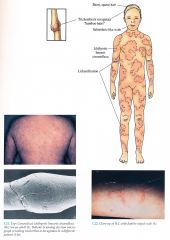![]()
![]()
![]()
Use LEFT and RIGHT arrow keys to navigate between flashcards;
Use UP and DOWN arrow keys to flip the card;
H to show hint;
A reads text to speech;
11 Cards in this Set
- Front
- Back
|
Clinical Netherton Syndrome/ Ichthyosis linearis circumflexa
|

|
|
|
Inheritance
|
Autosomal recessive; SPINK5 gene on 5q32
|
|
|
Prenatal Diagnosis
|
DNA mutation analysis if defect known in family
|
|
|
Incidence
|
Rare with a few dozen case reports; M=F; observed M:F=1:2
|
|
|
Age at Presentation
|
Birth to first few months of life
|
|
|
Pathogenesis
|
Mutations in SPINK5 gene encoding LEKTI, a serine protease inhibitor that may be
important in clownregulating inflammatory pathways; LEKTI also associated with atopy |
|
|
Clinical
|
Skin
Birth Few Months Generalized erythema and scaling with secondary hypernatremia, failure to Thrive Later in Infancy Migratory erythematous, polycyclic, serpiginous plaques with double edged scale along the margins (ILC) Atopic dermatitis with flexural lichenification and pruritus Seborrheic like scale and erythema on face, scalp, eyebrows Hair Trichorrhexis invaginata (ball and socket configuration; bamboo hair) most characteristic; may also have pili torti or trichorrhexis noclosa; eyebrow hair may be most common site Short, sparse Immunology Anaphylactic reactions to foods |
|
|
D/Dx
|
Congenital ichthyosiform erythroderma (p. 12)
Seborrheic dermatitis Dermatophytosis |
|
|
Lab
|
Light microscope examination of hair shaft
Increased serum immunoglobulin E (IgE) KOH |
|
|
Management
|
Monitor in infancy for hypernatremia, and failure to thrive
Referral to dermatologist topical therapy, retinoids; avoid keratolytics (can worsen condition) and tacrolimus ointment (increased absorption from compromised skin barrier with increased risk of toxicities) Referral to allergist radioallergosorbent assay test (RAST) |
|
|
Prognosis
|
May have partial remissions and may improve at puberty; normal life span
|

